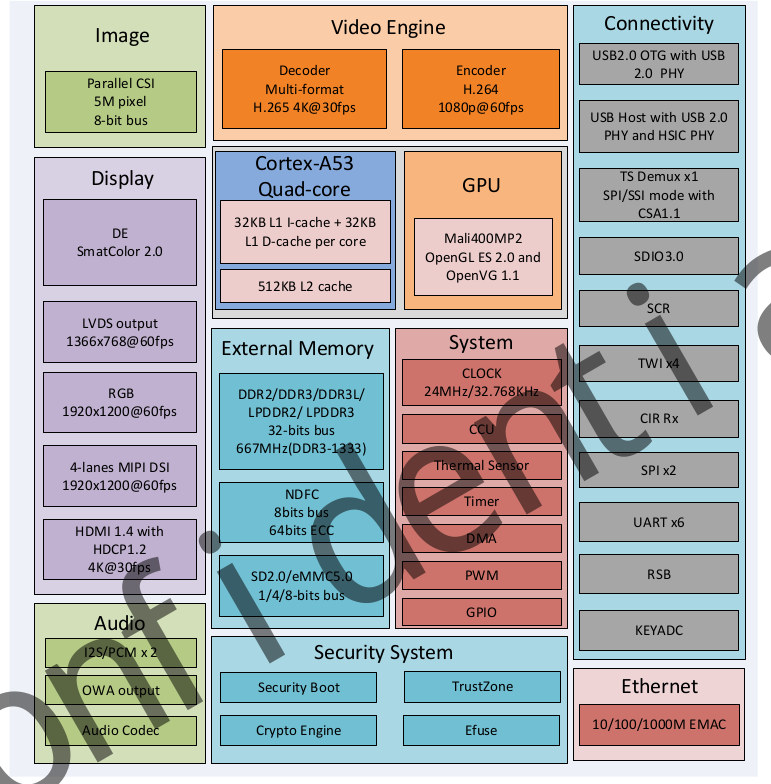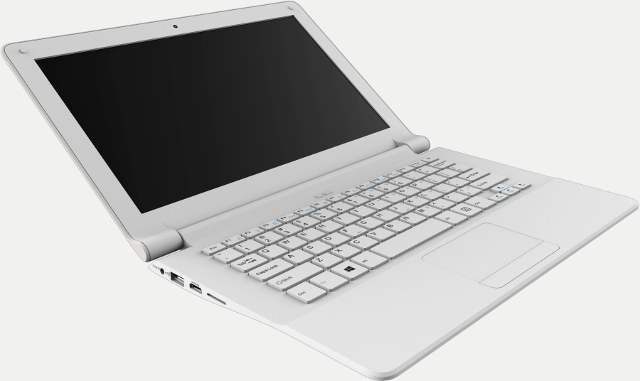Allwinner has two 64-bit ARM processors in the works: Allwinner H64 and Allwinner A64. Both are quad core Cortex A53 processors with a Mali-400MP2 GPU, H.265 4K video playback with basically the same interfaces and peripherals, but H64 also supports H.264 at 4K resolutions, while A64 is limited to H.264 @ 1080p, and H64 adds a TS interface.

The first good news is that two boards are in development:
- Orange Pi Plus 3 with Allwinner H64
- Olimex A64-OLinuXino update with Allwinner A64
Engineering samples have already been produced for the first board, but that’s about all the information we have now, as Shenzhen Xunlong has not built its reputation by releasing documentation early. One the other hand, A64-OLinuXino schematics have nearly been completed, but we already know more details, as not only Olimex boards are open source hardware, but the company defies conventional wisdom by involving the community in the development process early. So they published the first revision of the Kicad schematics on Github to get feedback.
And together with their own work, they’ve also released the datasheets of the main components including A64 datasheet and TRM:
- Allwinner A64 datasheet (63 pages)
- Allwinner A64 user’s manual (720 pages)
The third good news is that A64-OlinuXino Allwinner A64 board should eventually be used in a 64-bit ARM DIY laptop made by Olimex themselves.

At some points, we’ll also need some bootloader and Linux source code for Allwinner A64, but that’s the next step.

Jean-Luc started CNX Software in 2010 as a part-time endeavor, before quitting his job as a software engineering manager, and starting to write daily news, and reviews full time later in 2011.
Support CNX Software! Donate via cryptocurrencies, become a Patron on Patreon, or purchase goods on Amazon or Aliexpress





Too bad, they use very old and weak GPU. Just forget it
i would love it if they made it into a laptop with proper source code support in the linux kernel..
Looking at the chromebooks that use rk3288 , this too might be successful. Fingers crossed..that it wouldn’t be too expensive.. maybe chromebook price? around 200 usd hopefully.
It has gigabit Ethernet, but a weak CPU, no USB 3.0, and no SATA. meh
The laptop from Olimex does sound a little interesting though.
Why did they put a 1080P60 h.264 encoder on the chip with a camera interface that can only capture at 1080P30? They needed to support MIPI-CSI. Doesn’t look like their is a camera ISP on the chip either. So this chip only has mid-range camera support.
@Jean-Luc Aufranc (CNXSoft)
A64 datasheet link points to the A64 user manual.
this is one of the longest between announcement and release for allwinner chip.
A20 used to be really nice, but since then Allwinner is kind of going downhill, how relevant is it these days? It looks like mediatek, hisilicon and rockchip are the real winner these days for low-cost boards? Yes it matters to go with the winners when you pick up a chip for the long-term.
@xxiao maybe my most wanted review from cnxsoft: a comparison of low cost boards! for me complete open source code + support is the most important, and from that perspective my list begin: qualcomm: 410c 96board – $75 linaro support mainstream kernel + android raspberry: pi2 – $35 raspberry foundation support mainstream kernel. amlogic: odroid c1+ – $38 hk+amlogic support kernel + android. gbe samsung: odroid xu4 – $75 hk support kernel + android. + usb3 nvidia: jetson tk1 – $99 nvidia support kernel (mainstream?) + android. + sata/usb3/gbe jetson tx1 – $599 well price too high. xilinx: parallella dtp… Read more »
@klein
Mediatek only provide developer boards to large company, except via Mediatek Labs with LinkIT ONE, and some OpenWRT boards.
@tahm
Olimex targets 200 to 300 Euros for that laptop (with a 1366×768 display).
@klein
For the time being, I put some hope in Linaro to make true what they are promising for years – but even more in the Raspberry Pi Foundation (and community) that they keep up the great support AND will come up rather soon with a new model, respectively. And that especially the GPU/VPU-driver will finally be open source and indeed good and ready to use. From what I know, there is quite some development, but still a way to go.( https://en.wikipedia.org/wiki/Free_and_open-source_graphics_device_driver#Free_and_open-source_drivers )
@klein
“allwinner is in my opinion the worst kernel quality”
Not totally true.
a10/a20 have very good support on mainstream kernel for headless servers.
Debian even has a install image for cubieboards, bananapi, orangepi, etc, what more do you want??
other than all those media-centric reviews, would love to see cnxsoft to introduce more router-boards, i.e. those with two NICs and wifi while gpu/vpu is not that important. I have yet to see some opensource router-board these days, with wifi and 2+ NICs, probably even with some SATA. please don’t count those two-NIC that sharing some USB logic underneath, that’s a joke. We had enough media-board these days
@xxiao
Router boards are interesting but I don’t see that many. They are low volume so it’s difficult to keep the price down (e.g. FireWRT and WiTi), and retail routers will be quite cheaper and fulfill the requirements of people who don’t use I/Os headers, with several of them supporting OpenWRT.
@Jean-Luc Aufranc (CNXSoft) Orange Pi model is Orange Pi 3 with H64 chip. Orange Pi 3 will has 2GB ram and 16GB EMMC flash, Wifi/BT, gigabit ethernet,Mipi-DSI and so on. Orange Pi 3 will has super lower price. You can look forward.
@Steven
It will also have another great feature: inability to properly run a Linux desktop….
1366*768 for the laptop
@xxiao http://www.cnx-software.com/2015/10/24/gigglebits-hackable-arm-fpga-router-comes-with-an-spf-cage-and-5-gigabit-ethernet-ports-crowdfunding/
Product page for Olimex Laptop now called “TERES-I Do-It-Yourself Open Source Hardware and Software Laptop with ARM64 and x86 processors.”: https://www.olimex.com/Products/DIY%20Laptop/
Not that many details for now.
cnxsoft
I don’t see how one will add more memory to TERES if the current PCB was not designed with SO-DIMMs in mind. But maybe that’s just my eyes.
https://olimex.wordpress.com/2016/08/31/teres-i-diy-open-source-hardware-hackers-laptop-update/

@blu
You’d have to replace the complete CPU card with one having more memory.
@blu
Quoting Olimex: ‘different main board configurations: first with ARM64 and x86 later, MIPS and other architectures may follow’. It’s OSHW anyway and most probably the next SoC suitable for the laptop will have a totally different memory configuration so you end up with soldered DRAM and replaceable CPU cards anyway.
BTW: As far as I understood combining ultra low-power LPDDR(4) with SO-DIMMs (inventing contact resistance and problems) seems no good idea at all.